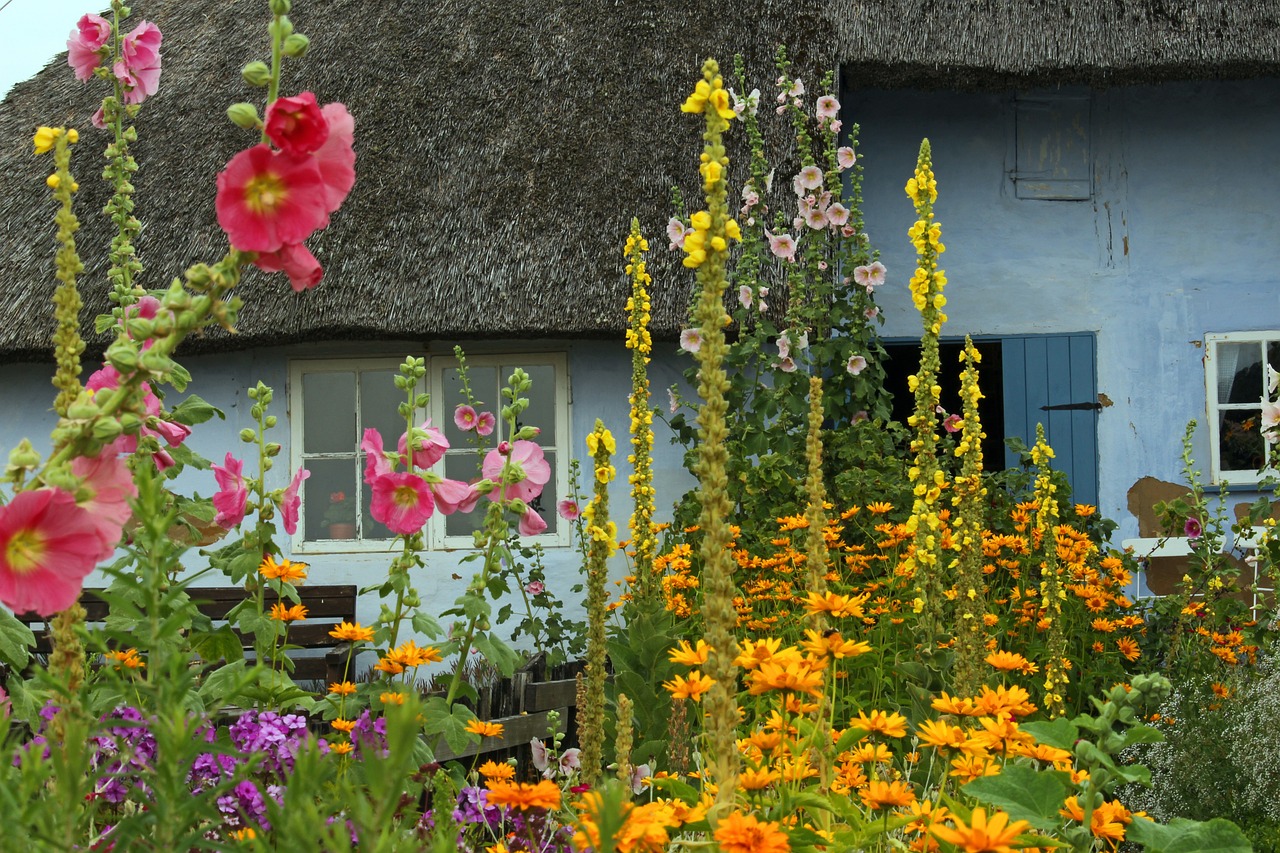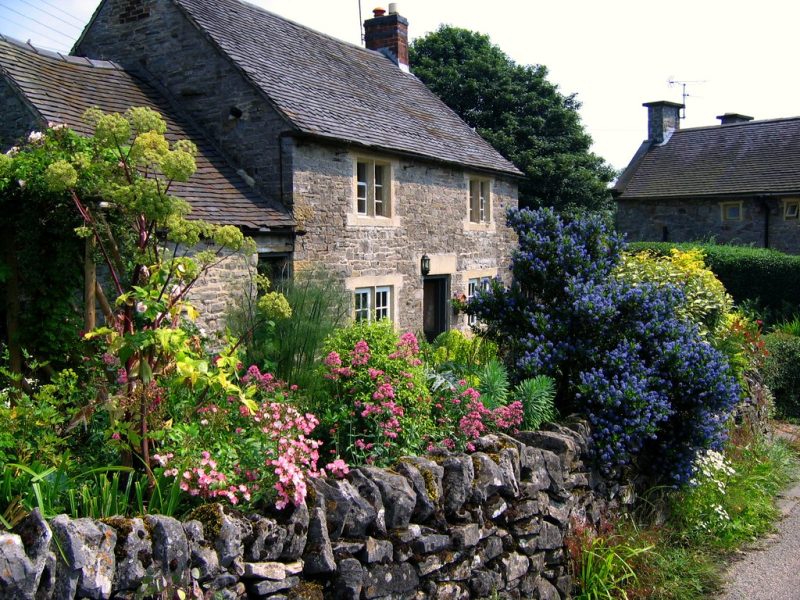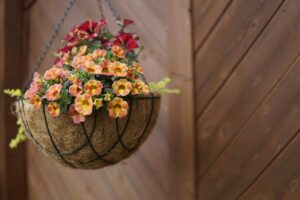A Cottagecore garden embodies the aesthetic and philosophy of a slower, more romanticized approach to rural life. This design style draws inspiration from the simplicity of country living, emphasizing a connection to nature, serene beauty, and traditional gardening practices.
What Is A Cottagecore Garden?
Characterized by an abundance of flowers, lush greenery, and charming layouts, such gardens invite wildlife, promote biodiversity, and create an oasis of tranquility. The essence of Cottagecore lies not just in the visual composition but also in the immersive experience it offers—a sanctuary for daydreaming, creativity, and reflection. These gardens often integrate rustic elements, such as trellises, arbors, and pathways made of reclaimed materials, which contribute to the overall vintage feel and invite visitors to explore every nook and cranny.
Planning A Cottagecore Garden
The journey to creating a Cottagecore garden begins with thoughtful planning that harmonizes with the surrounding environment and reflects personal aesthetics. First, assess your space, whether it be a sprawling yard or a modest balcony, and imagine the atmosphere you wish to cultivate.
Sketching a layout can help visualize elements like garden beds, seating areas, and pathways which will encourage exploration. Prioritize native plants and those that flourish in your climate, as these will establish a sustainable ecosystem that requires less maintenance and encourages local wildlife, including bees and butterflies, to visit.
Consider integrating whimsical features like a small pond, birdbaths, or even a cozy nook for reading or tea time. Incorporating elements of vintage decor, such as weathered furniture or handmade crafts, can also imbue the garden with personality and charm, enhancing the overall Cottagecore ambience.
Plants With Cottagecore Appeal
The plants selected for a Cottagecore garden should evoke a sense of nostalgia and tranquility. Classic choices include heirloom varieties, such as fragrant roses, peonies, and daisies, which not only look picturesque but also carry historical significance and traditional associations.
Consider adding soft, cascading plants like wisteria or honeysuckle to drape over pergolas and trellises, creating dreamy, secluded spaces. Herbs play a vital role too; towering lavender is not only visually pleasing, but its scents can create an inviting atmosphere while providing culinary use.
Planting a mix of perennials and annuals brings ongoing vibrancy throughout the changing seasons. Aim for layers of color and texture, using sunflowers and cosmos for pops of brightness against a backdrop of lush foliage.
Additionally, incorporating wildflowers can tap into the naturalistic element of Cottagecore, offering a sense of untamed beauty reminiscent of rural meadows. Each plant choice not only enhances the visual appeal of the garden but also helps foster the serene, pastoral spirit that defines Cottagecore living.
Bellflower
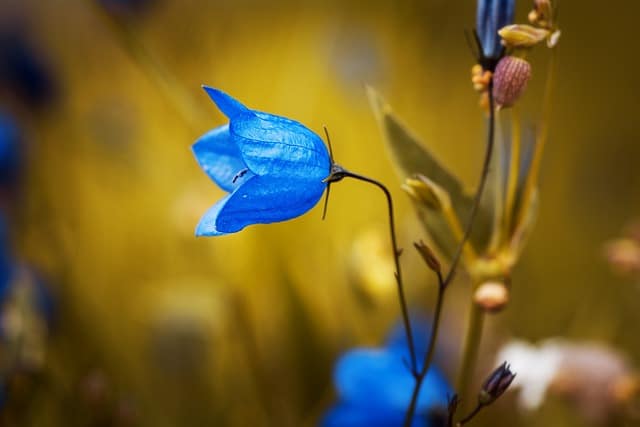
Bellflowers, with their dainty, bell-shaped blossoms, bring a delightful charm to any Cottagecore garden. The versatility of this plant shines through its various species, ranging from the low-growing Campanula carpatica to the taller Campanula glomerata. These hardy perennials thrive in a range of conditions, making them easy to incorporate into diverse garden layouts. Their colors can span from pale blues and whites to deep purples, allowing for a beautiful layering effect when planted alongside other flowers.
In a Cottagecore setting, bellflowers can act as a graceful border along pathways or as fillers in mixed beds, where their nodding blooms seem to engage in a gentle conversation with the visiting bees. Additionally, these flowers can symbolize gratitude and humility in the language of flowers, adding a layer of meaning to your garden. To enhance the Cottagecore aesthetic, consider pairing them with rustic elements, such as weathered stones or antique garden tools, which can serve as beautiful backdrops for their delicate beauty.
Bigleaf Hydrangea

Bigleaf hydrangeas (Hydrangea macrophylla) are another staple in the Cottagecore garden, exemplifying lushness and abundance with their large, rounded clusters of blooms. These hydrangeas are particularly valued for their stunning blooms, which can shift colors based on soil pH—ranging from vibrant blues in acidic soil to soft pinks in alkaline conditions. This dynamic color change can create a captivating display throughout the growing season and add a whimsical aspect to the garden.
Positioned near a cozy seating area or under the dappled shade of a tree, these hydrangeas can create a stunning focal point, inviting admiration and contemplation. Moreover, they thrive in borders and along walkways, enveloping visitors in a visually rich sensory experience. To maintain the Cottagecore theme, consider incorporating vintage vases filled with fresh cut hydrangeas on quaint rustic tables, thereby extending the charm of this vibrant plant from the garden into your home decor. The lush foliage and vibrant blooms of bigleaf hydrangeas offer not only visual delight but also connect seamlessly to the lush, pastoral aesthetics of the Cottagecore ethos.
Columbine
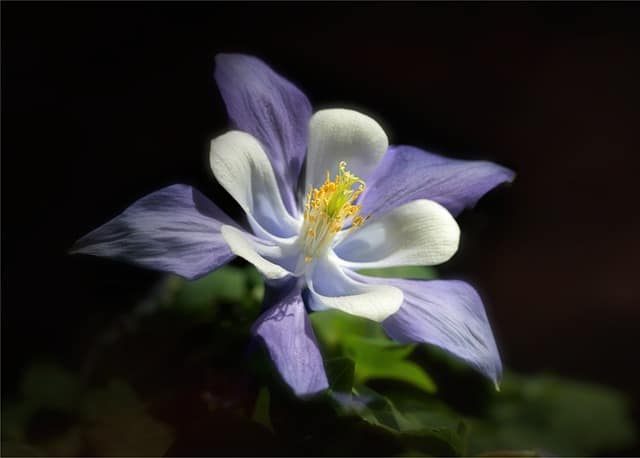
Columbine (Aquilegia) is an enchanting perennial that embodies the whimsical spirit of a Cottagecore garden. Known for their unique, spurred flowers that resemble delicate lanterns, columbines come in a plethora of colors, from striking reds to subtle pastels. These flowers attract pollinators like hummingbirds and butterflies, playing a vital role in maintaining a lively ecosystem within the garden. Their ethereal appearance draws the eye and evokes the imagination, reminding one of fairytales and enchanted woodland clearings.
Consider planting columbine in clusters among the taller plants to create depth and movement in your garden design. Their feathery foliage provides texture while their nodding blooms add a sense of softness and grace. To amplify the Cottagecore charm, place columbine near rustic elements such as a vintage watering can or in a quaint flower bed bordered with old bricks or stones. Their return each spring further enhances the notion of continuity and renewal that is central to the Cottagecore ethos, encouraging a deep appreciation for the cycles of nature and the passage of time. By integrating columbine into your garden, you create not just a beautiful environment but also a magical setting that invites daydreaming and exploration.
Coral Bells

Coral bells (Heuchera) are an excellent addition to a Cottagecore garden, celebrated for their striking foliage and delicate flower spikes. These perennial plants come in a variety of colors, ranging from deep burgundy to vibrant lime greens, adding visual interest even when not in bloom. Although the flowers, typically small and bell-shaped, may not steal the spotlight, they bring a soft, airy quality to the garden that enhances the whimsical atmosphere.
Ideal for shaded or partially sunny areas, coral bells can brighten up darker corners of your garden, creating a lush understory beneath taller plants. Their leaves can provide a perfect backdrop for flowering companions like daisies or delphiniums, helping to define garden beds and create colorful layers that draw the eye. To integrate coral bells into your Cottagecore design, consider using them in a mixed border or as part of a charming woodland-themed garden, where their rich hues can contrast beautifully against the greens of surrounding foliage. Additionally, incorporating them into decorative containers can enhance the allure, welcoming visitors to linger and admire their intricate textures and colors, embodying the essence of a cozy and inviting garden space.
Daisy
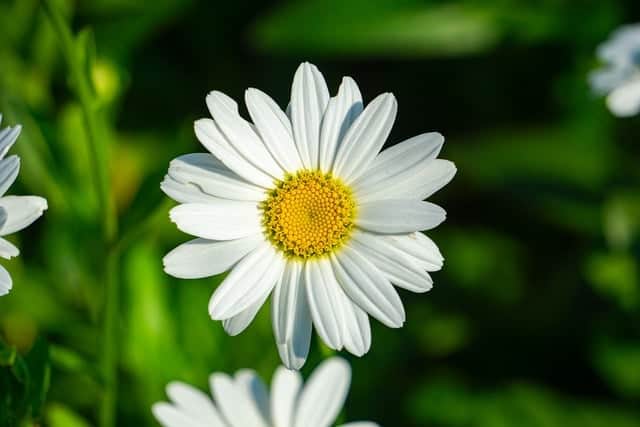
The humble daisy (Bellis perennis) is a timeless symbol of purity and innocence—qualities that harmonize perfectly with the Cottagecore aesthetic. Known for their simple, cheerful flowers with white petals and sunny yellow centers, daisies exude a friendly and welcoming vibe, making them ideal for creating a laid-back, rustic garden atmosphere. Their resilience and ease of growth ensure that they flourish in a variety of conditions, bringing life and color to one’s outdoor space.
Daisies fit seamlessly into a Cottagecore garden as they can be scattered throughout the landscape, planted in drifts, or arranged in charming bunches to enhance the informal, cottage-like feel. They can grow alongside other perennials like bellflowers or columbines, creating a tapestry of textures and colors. Daisies also lend themselves wonderfully to the creation of wildflower plots, evoking a sense of nostalgia for meadows filled with carefree blooms. Additional elements like wicker baskets filled with fresh-picked daisies can serve as delightful accents, inviting fleeting moments of joy and spontaneity. With their association with simplicity and natural beauty, daisies not only beautify the environment but also contribute to the peaceful ambiance that defines a Cottagecore garden.
Delphinium
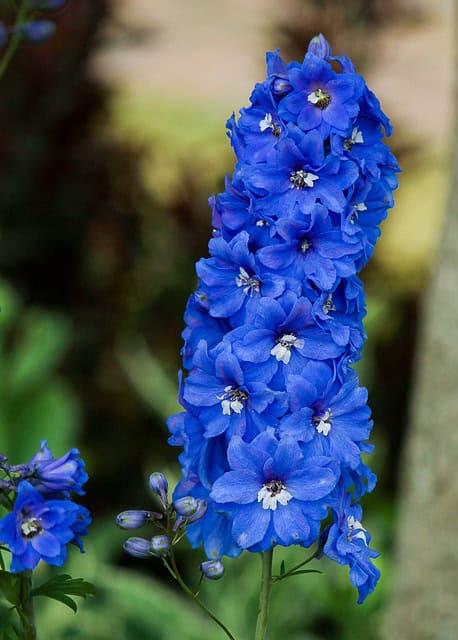
Delphiniums (Delphinium spp.) are imposing yet elegant additions to any Cottagecore garden, renowned for their tall, spiky blooms that create a majestic vertical accent in the landscape. These perennials produce striking flowers in a myriad of colors, including deep blues, bright whites, and soft lavenders, infusing your garden with vibrant hues that arrest the senses. Known for their statuesque nature and flower spikes that can rise to impressive heights, delphiniums add drama and sophistication, contrasting beautifully with the softer forms of daisies and the delicate foliage of coral bells.
These flowers thrive in full sun and prefer well-drained soil, making them an ideal choice for sunny borders or mixed flower beds. When planted in groups, delphiniums can create a stunning backdrop for shorter cottage plants, weaving a lush, harmonic flow throughout the garden. With their ability to attract pollinators, they further enhance the garden’s biodiversity. To embellish your Cottagecore garden with delphiniums, consider positioning them near pathways or focal points, so their towering blooms can greet visitors with confidence and charm. A bouquet of freshly cut delphiniums can also bring that same elegance indoors, connecting the beauty of the garden with the warmth of home. By incorporating delphiniums thoughtfully, you amplify the enchanting atmosphere of a Cottagecore garden while highlighting the beauty of nature’s diverse palette.
Dianthus

Dianthus, often affectionately referred to as “pinks” or “carnations,” are charming additions to a Cottagecore garden, exuding an old-fashioned allure that aligns perfectly with the aesthetic’s emphasis on nostalgia and romance. These perennial and annual varieties bloom in a range of colors, including soft pinks, vibrant reds, and whites, often featuring delightful frilled edges that give them a delicate yet robust appearance. Beyond their visual appeal, dianthus are also prized for their sweet fragrance, which can evoke memories of summer afternoons spent wandering through flower fields.
Incorporating dianthus into a Cottagecore garden allows for creative expression; they can be planted en masse for a vibrant carpet of blooms or intermingled with other flowers for a more textured look. Their ability to thrive in well-drained soil and sunny spots makes them versatile companions for other perennials and annuals. Furthermore, dianthus can be used as ground cover to soften pathways or borders, creating friendly transitions between garden elements. To enhance the Cottagecore atmosphere, consider placing dianthus in quaint stone or rustic wooden planters, where their beauty can be admired up close while sipping tea or enjoying a good book. The gentle presence of these flowers adds to the overall warmth and charm that embodies the essence of a Cottagecore garden.
Foxglove
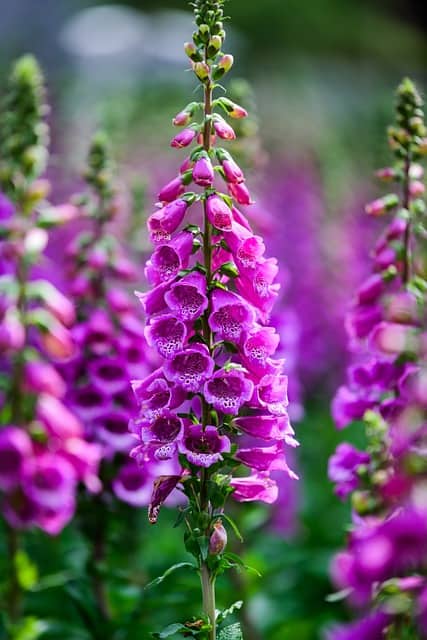
Foxglove (Digitalis purpurea) stands as an iconic representative of the Cottagecore garden, renowned for its captivating, tall flower spikes adorned with tubular blossoms that tempt hummingbirds and bees alike. These enchanting flowers bloom in shades ranging from soft pinks to vibrant purples and whites, creating vertical accents that draw the eye upward, highlighting the garden’s lushness. The slight wildness of foxglove, complemented by its cottage garden history, embodies the concept of harmonious chaos that characterizes a well-loved outdoor space.
Foxgloves thrive in partially shaded areas, making them ideal for planting near the edges of trees or alongside other shade-loving plants, such as ferns. This ability to flourish in diverse settings allows gardeners to create layered designs that mimic the natural growth found in meadows and woodland clearings. Additionally, foxgloves can lend an element of fairy-tale whimsy to your garden, particularly when planted in clusters that create an enchanting display. When selecting foxglove for your Cottagecore garden, consider leaving some blooms to mature into seed heads, which can add texture and even self-seed for future seasons, reinforcing the organic, ever-changing nature of your landscape. Their majestic beauty will surely inspire admiration and, ultimately, a sense of nostalgia for simpler times.
Hollyhock
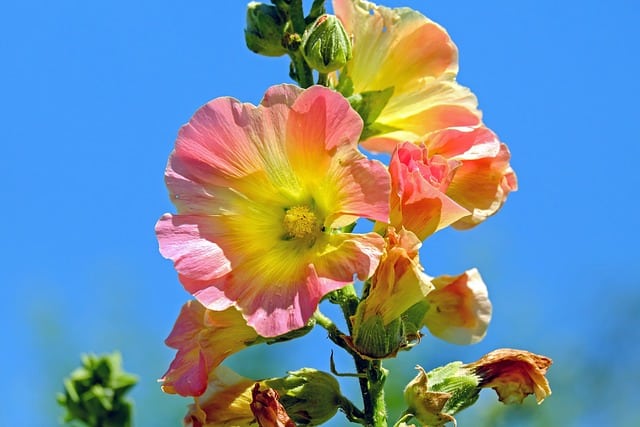
Hollyhocks (Alcea rosea) are quintessentially charming flowers that epitomize the Cottagecore garden aesthetic with their tall, stately stalks adorned with large, showy blooms. Often seen gracing old cottage gardens, hollyhocks come in a delightful array of colors—think soft pastels, rich reds, yellows, and whites—infusing spaces with warmth and vibrancy. Their impressive height can create a dramatic vertical element in your garden, serving as a backdrop for shorter flowering plants and guiding the gaze upward.
To incorporate hollyhocks into your Cottagecore garden, consider planting them along fences, walls, or garden borders, where they can sway gracefully in the breeze and add a cottage-like charm. Holes or gaps in a fence can be filled with them – their climbing nature will allow them to creep and meander around structures, creating a whimsical and inviting environment. They are somewhat easy to grow but do thrive best in sunny spots with well-drained soil. Allowing some flowers to go to seed will also promote a thriving self-seeding population, bringing forth new life and unexpected surprises each season.
For a more enchanting feel, consider staging hollyhocks alongside rustic elements, like a weathered wheelbarrow or a quaint garden bench, inviting visitors to take a moment to bask in the beauty of the blooming garden. Hollyhocks not only serve as an eye-catching element of structure and color but also resonate deeply with the nostalgic, pastoral spirit that defines the Cottagecore movement, making them an essential addition to create that idyllic and dreamy landscape.
Iris

Irises are strikingly elegant flowers that bring both drama and grace to any Cottagecore garden. With their graceful, sword-like foliage and intricate blooms, these perennials are a visual feast. Available in an array of hues—rich purples, soft blues, and sunny yellows—irises not only add a splash of color, but also create a sense of depth and structure within the garden landscape. Their unique shapes and textures encourage exploration, inviting visitors to admire the iconic “bearded” varieties or the ethereal beauty of the more delicate Dutch iris.
These charismatic flowers thrive in well-drained soil and can tolerate various light conditions, although they flourish most in full sun. Planting irises near paths or in mixed borders will enhance their enchanting presence, establishing gentle contrasts against softer blooms like daisies and coral bells. Not only do irises provide visual interest, but they often symbolize faith, hope, and wisdom, enriching the atmosphere of the garden with a layer of meaning that aligns perfectly with the Cottagecore ethos. Incorporating irises amid rustic features—such as an old wooden trellis or a charming birdbath—will further amplify the idyllic whimsy of a Cottagecore garden, creating serene pockets of beauty that whisper tales of elegance and nostalgia.
Lady’s Mantle
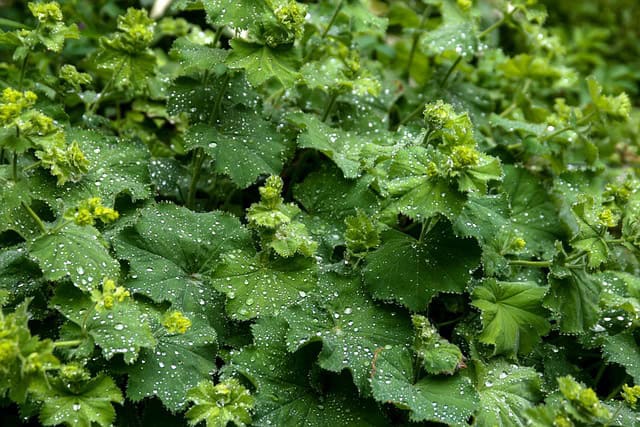
Lady’s Mantle (Alchemilla mollis) is a wonderfully versatile perennial that can elevate the Cottagecore garden’s gentle, pastoral vibe. Known for its lush, rounded leaves—formed like delicate cups with a unique serrated edge—Lady’s Mantle not only captures raindrops and morning dew, adding a brilliant sparkle to the garden, but also embodies the soft, nurturing qualities that resonate with a cozy countryside aesthetic. The tiny yellow-green flowers bloom in soft clusters, creating a delicate contrast against the robust foliage.
This plant thrives in both sunny and shady spots, making it an adaptable choice for various garden settings. For a truly enchanting atmosphere, consider planting Lady’s Mantle in drifts among taller flowers like hollyhocks or delphiniums, where its textured leaves create a lush underlayer that complements the vertical elements of the garden. Their foliage is also fantastic for creating informal pathways or borders, softening hard edges and inviting a sense of movement. Coupling Lady’s Mantle with rustic elements—such as a hidden bench beneath a sprawling tree or flowering shrubs—will create intimate spaces that encourage reflection and connection with nature, perfectly embodying the Cottagecore concept of finding beauty amidst simple, natural elements.
Lavender
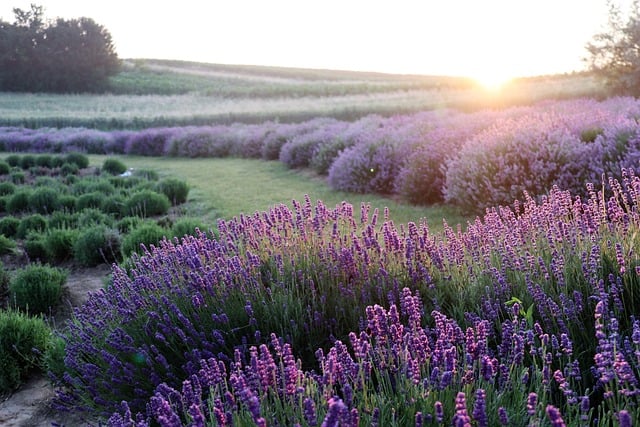
Lavender (Lavandula) is a fragrant staple in any Cottagecore garden, known for its timeless allure and soothing scent. With its slender, gray-green leaves and striking purple flower spikes, lavender not only brings visual charm but also offers a sensory delight that transports one to sunlit lavender fields. Its delightful aroma can invoke relaxation, perfectly complementing the tranquil atmosphere one seeks in a blissful garden sanctuary.
This drought-tolerant plant thrives in sunny locations and well-drained soil, making it an easy addition that requires minimal maintenance. When integrated into garden beds, lavender can form fragrant borders or provide vertical interest as part of a mixed display with taller perennials and annuals. For those wanting to create a multi-sensory experience, consider incorporating lavender into pathways or near seating areas, where its scent can permeate the air, promoting a peaceful atmosphere for meditation or gentle conversations.
To enhance the Cottagecore aesthetic, pair lavender with rustic features such as reclaimed wooden pots or vintage watering cans, allowing their beauty to flow seamlessly into your garden décor. Additionally, harvesting lavender for use in sachets, teas, or culinary dishes allows you to bring a piece of your garden’s charm indoors, enriching your home with its delightful fragrance. With its enchanting beauty and historical significance, lavender embodies the very spirit of the Cottagecore movement—celebrating the connection between nature and daily life in a delightful way.
Peony
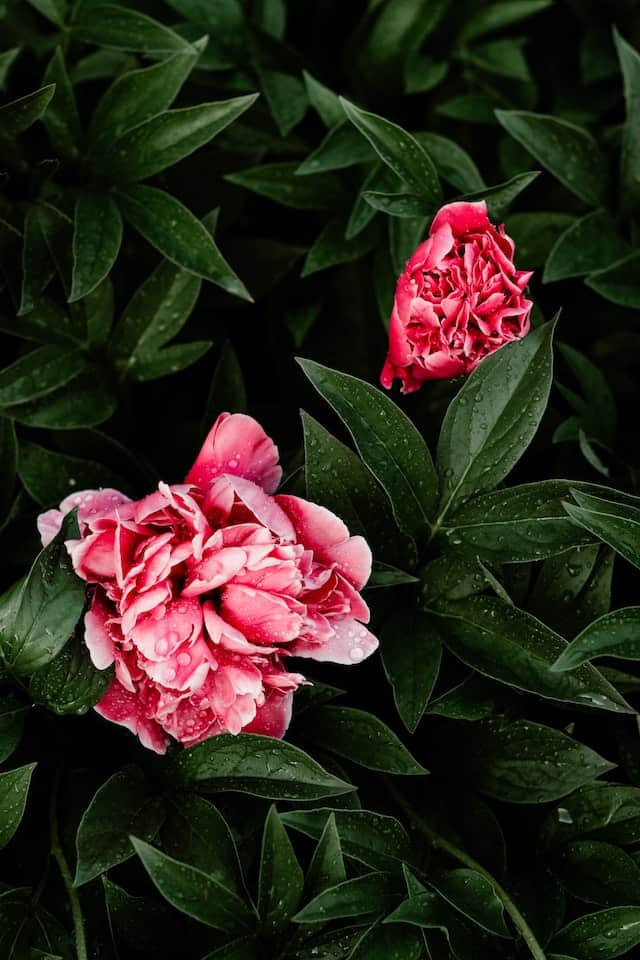
Peonies (Paeonia) are the quintessential statement flowers that elevate the Cottagecore garden with their lush blooms and intoxicating fragrance. Known for their large, ruffled petals that come in an array of colors including soft pinks, creamy whites, and deep reds, these perennial plants symbolize romance and prosperity. Their opulent blooms often evoke timeless beauty, making them a favored choice for cottage gardens that seek to embody a sense of nostalgia and elegance.
Peonies thrive in sunny locations and well-drained soil, where they will return year after year, expanding their lush foliage as they grow. To create a stunning display, consider planting peonies at the back of borders where their majestic blooms can take center stage, harmonizing beautifully with plants of varying heights. Pairing them with complementary florals such as delphiniums or daisies can create a visually dynamic effect. Their blooms make for splendid cut flowers, allowing the beauty of your garden to grace indoor spaces, creating a connection between your outdoor oasis and home.
In addition to their aesthetic value, peonies can act as a focal point for storytelling within your garden—a reminder of cherished memories or a celebration of new beginnings. For a touch of whimsy, consider incorporating trellises or ornamental fences nearby, inviting flowering vines to wind upward, creating a delightful and layered look. With their rich history and abundance of beauty, peonies embody the ideals of the Cottagecore garden, where every bloom offers a glimpse into nature’s remarkable artistry.
Perennial Geranium
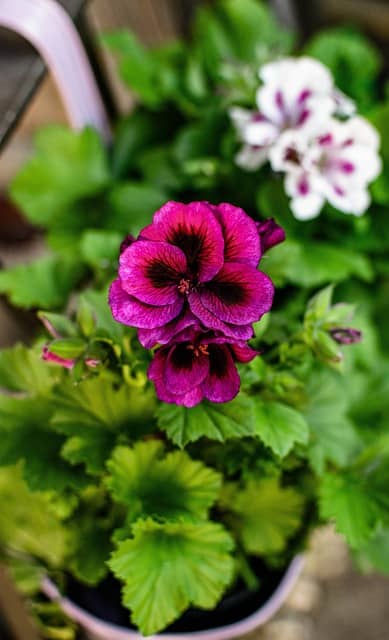
Perennial geraniums (Geranium spp.), often known as cranesbills, are a lovely addition to the Cottagecore garden, celebrated for their hardiness and adaptability. Offering delicate yet vibrant blooms in shades of blue, purple, pink, and white, these low-maintenance plants provide continuous blooms from spring to autumn, creating a tapestry of color that breathes life into any corner of the garden. Their heart-shaped leaves add texture and interest even when the flowers are out of bloom, ensuring that your garden retains its charm year-round.
These perennial geraniums thrive in a variety of conditions, from full sun to partial shade, making them versatile companions for other plants. Their sprawling habit makes them ideal for ground cover, effectively suppressing weeds and providing a lush, green backdrop for taller flowers or ornamental grasses. When used creatively, they can soften the edges of pathways or garden beds, enhancing the inviting atmosphere that Cottagecore seeks to achieve.
Incorporating perennial geraniums alongside other cottage staples like lady’s mantle or lavender creates a harmonious landscape filled with a myriad of textures and colors. Additionally, these resilient plants attract beneficial pollinators, contributing to a healthy garden ecosystem and further enriching your experience amid nature. With their delightful blooms and simple elegance, perennial geraniums encapsulate the tranquility and charm of the Cottagecore garden, providing a solid foundation from which other blooms can shine.
Phlox
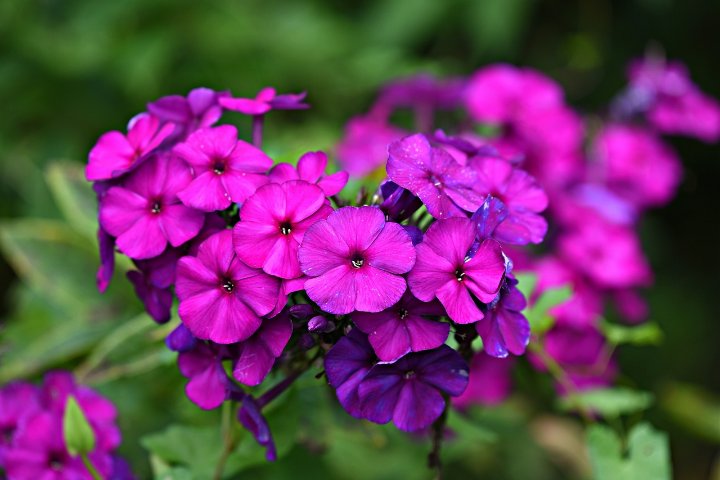
Phlox represents a delightful addition to a Cottagecore garden, renowned for their fragrant, colorful flowers and adaptability in various growing conditions. These perennials come in both creeping and upright varieties, boasting an impressive palette that includes vibrant shades of pink, blue, white, and purple. Their clusters of star-shaped blooms can create a blanket of color, drawing the eye and infusing the garden with a lively spirit reminiscent of traditional cottage gardens.
Phlox thrives in sunny locations, though some varieties are quite tolerant of partial shade, allowing for seamless integration in diverse areas of your garden. When planted in dense clusters, they can provide a captivating focal point, harmonizing beautifully with other flowers such as daisies and zinnias in a mixed border. Their intoxicating fragrance becomes particularly pronounced in the evening, further enchanting the atmosphere and making dusk a magical time to stroll through your garden.
In addition to their visual appeal, phlox supports beneficial insects, including butterflies and bees, which are essential for pollination within your garden. To enhance the Cottagecore vibe, consider incorporating phlox near rustic structures, such as a picket fence or an old garden shed, which can provide a picturesque backdrop for the vibrant blooms. Additionally, using phlox in various floral arrangements can bring the beauty of your garden indoors, creating inviting and fragrant displays that echo the charm of your outdoor sanctuary. In a Cottagecore garden, phlox serves as a gentle reminder of the beauty and complexity of nature, effortlessly blending whimsy with tradition.
Sweet William
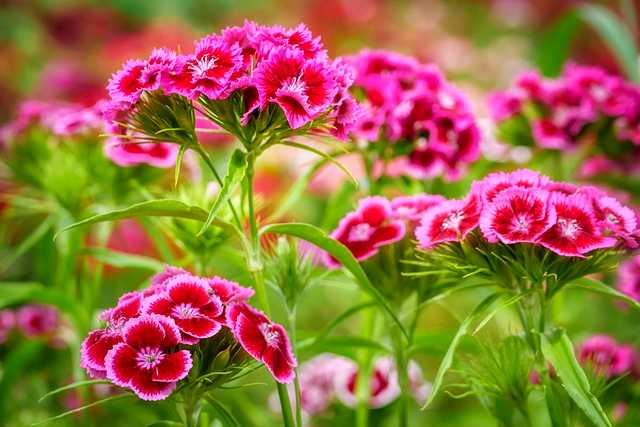
Sweet William (Dianthus barbatus) is a charming biennial or perennial flower that embodies the whimsical essence of the Cottagecore garden. With its dense clusters of delicate, ruffled blooms in vibrant hues of pink, red, white, and purple, Sweet William adds a cheerful pop of color reminiscent of forgotten blossoms from an 18th-century cottage. Its distinct fragrance, often described as clove-like, enriches the sensory experience of a garden, invoking nostalgia and welcoming pollinators such as bees and butterflies.
Planting Sweet William in sunny areas enhances their growth and flowering capabilities, and they thrive in well-drained soil. One of their unique features is their self-seeding nature, allowing them to return year after year, thereby creating a naturally evolving, carefree aesthetic that epitomizes Cottagecore charm. To fully immerse your garden in their vintage beauty, position them near rustic elements like stone pathways or wooden garden seats, where their bright blooms can invite visitors to pause and reflect.
In addition to their aesthetic qualities, Sweet William carries historical significance as a flower often associated with love and admiration, making it a beautiful choice for creating romantic garden spaces. Incorporating them into mixed borders or as part of cottage-style flower beds will ensure they attract attention while offering a sense of authenticity that is fundamental to the Cottagecore ethos. Their vibrant presence and delightful aroma transform any garden corner into a vibrant haven that celebrates the joys of nature.
Pansies and Violas
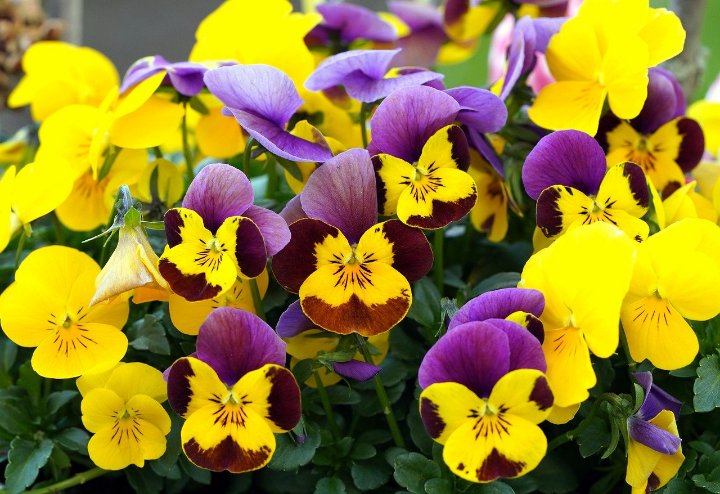
Pansies and violas are quintessential floral companions in any Cottagecore garden, known for their charming faces and diverse colors. Pansies, with their large, velvety petals, and violas, which feature smaller blooms and a more delicate structure, both boast a captivating variety of hues—from sunny yellows to rich purples and soft pastels. Their unique markings and patterns resemble painted art, adding whimsical character to flower beds. The cheerful essence of these flowers seamlessly complements the romantic, inviting atmosphere that is intrinsic to Cottagecore.
These hardy annuals thrive in cooler weather, making them suitable for spring and fall gardens, and they can adapt to various soil conditions. Pansies and violas are perfect for containers, hanging baskets, or edge planting around garden beds, providing good drainage and sunny to partially shaded spots. Their versatility allows for a creative blending with other blooms or foliage, offering endless opportunities for stunning arrangements.
Beyond their beauty, pansies and violas have culinary potential; they can be used as edible garnishes or ingredients in salads, showcasing the Cottagecore belief in celebrating the simpler joys of life. To enhance their whimsical charm, consider using them in conjunction with rustic decorative elements, like vintage teacups or wooden crates, to create delightful displays that inspire creativity and playfulness. The joyful presence of pansies and violas enriches the Cottagecore garden, inviting both the senses and the imagination to flourish.
Decorations
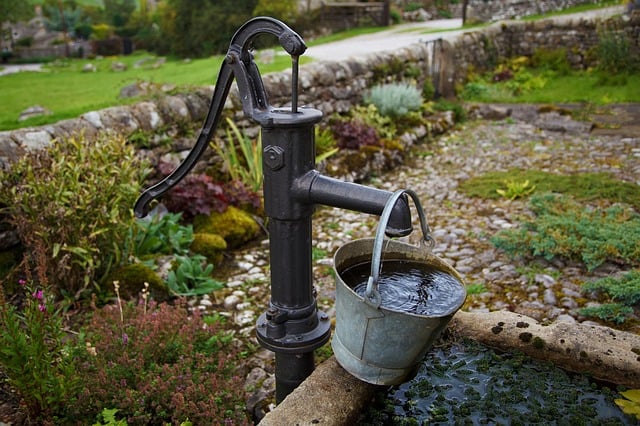
Decorations play an integral role in cultivating the enchanting atmosphere of a Cottagecore garden, creating unique focal points that speak to the beauty of simplicity and nature. Emphasizing rustic charm, decor elements can be sourced from thrift stores, nature walks, or crafted from repurposed materials. Garden decorations can range from vintage decorative items—like antique watering cans, weathered wooden benches, or wrought iron gates—to handmade touches like wind chimes crafted from natural materials or garden signs with whimsical sayings.
A carefully curated collection of decorations can tell the story of your garden, adding depth and personality to the spaces within. For instance, hanging bird feeders or cozy hammocks can enhance the garden’s allure while inviting wildlife to join in the experience. Fairy lights strung between trees or along garden fences can create a magical ambiance for evening gatherings, fostering an inviting atmosphere that encourages connection and relaxation.
In addition to functional decor, consider incorporating artistic elements such as painted stones or mosaics that reflect the colors and themes of your garden. Garden art can be a delightful focal point, capturing the imagination and inspiring creativity. Using elements from nature—like driftwood sculptures or floral arrangements in vintage bottles—adds a personal touch that celebrates the whimsy of the natural world.
Ultimately, decorations in a Cottagecore garden act as a bridge between the surrounding beauty and personal expression. They help transform a simple garden into a serene retreat, infusing it with stories, memories, and warmth that resonate with the idyllic spirit of Cottagecore living. Whether it’s an artfully arranged seating area to foster conversations or an inviting path lined with handmade ornaments, each decorative choice helps paint a picture of tranquility and joy, weaving a rich tapestry of life within your garden.
Urban Cottagecore
Urban Cottagecore is an exciting and innovative twist on the traditional Cottagecore aesthetic, allowing city dwellers to cultivate an enchanting garden sanctuary amidst the hustle and bustle of urban life. This movement embraces the charm of country aesthetics while adapting it to compact spaces, balconies, rooftops, and community gardens, transforming ordinary urban settings into lush green retreats filled with the warmth of nature.
In an Urban Cottagecore garden, creative container gardening becomes essential. Small spaces can flourish with the careful selection of pot sizes and types. Terracotta pots, vintage buckets, and hanging planters can all play a vital role in layering plants such as herbs, flowers, and even small vegetables. Culinary herbs like basil, thyme, and rosemary not only provide fragrance and flavor but also encourage a connection to the kitchen and gardening. These little green havens can also feature trailing plants like ivy or string-of-hearts, cascading over shelves or railings, creating a sense of abundance even in the most confined quarters.
Incorporating natural materials and reclaimed objects into garden decor enhances the Urban Cottagecore aesthetic. Think wooden pallets turned into vertical planters, repurposed crates as seating, or old ladders transformed into plant stands. Such touches add character, telling a story of sustainability and creativity while embracing the gentle, pastoral essence that Cottagecore embodies.
In addition to personal outdoor spaces, Urban Cottagecore can foster community connections through initiatives like shared gardening projects in communal spaces, rooftop gardens, or city farming programs. By uniting neighbors in their passion for cultivating greenery, these projects can inspire collaboration and strengthen bonds, bringing the reflecting peace of a cottage garden into the urban landscape.
Bringing nature into urban settings also contributes to mental well-being. Urban Cottagecore embraces the idea of mindfulness and slow living, allowing city dwellers a serene escape from the frenetic pace of modern life. Creating tranquil corners with comfortable seating, perhaps adorned with soft cushions or a warm throw, invites moments of reflection and relaxation. Moreover, the splendor of seasonal blooms can transform everyday urban routines, reminding individuals of the beauty that exists naturally, even in unexpectedly small spaces.
Through Urban Cottagecore, the ideals of simplicity, self-sufficiency, and harmonious living can flourish, even in concrete jungles. It celebrates the idea that urban living does not have to be devoid of nature or the cozy, nostalgic charm of cottage life. By embracing creativity, sustainability, and community, individuals can cultivate enchanting urban gardens that reflect the heart of the Cottagecore movement, creating green havens of beauty, solace, and connection within the vibrant tapestry of city life.


